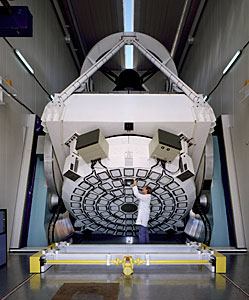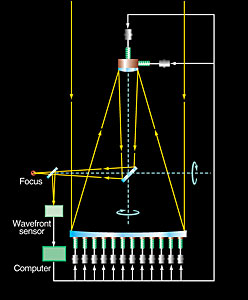Active Optics
Inventing a game changer
Size really does matter and so does shape. Both are important when it comes to constructing more powerful telescopes. Bigger primary mirrors allow astronomers to capture more light and a perfectly shaped mirror surface is needed to avoid distortions; the effective combination of the two makes it possible to observe fainter objects. Unfortunately, this has never been easy, as maintaining a perfect shape becomes harder as telescope mirrors become larger.
This challenge became important in the sixties and seventies. The technology available at the time did not allow astronomers and engineers to build telescopes with primary mirrors over 5 metres in diameter. Over that size, the image quality decreased enormously as gravity pulled on the mirrors out of shape. Using the technology of the time to build mirrors over 5 metres in diameter would have required huge structures to support the mirrors and higher construction costs, resulting in a prohibitively heavy structure without the promise of a better view. A new way had to be found to ensure optical accuracy.
That’s when ESO engineer Raymond Wilson came up with a brilliant and “simple” idea called active optics. A thin and deformable primary mirror would be controlled by an active support system that would apply the necessary force to correct for gravitationally-induced deformations as the telescope changes its orientation (read more in the free book Jewel on the Mountaintop by Claus Madsen).
When ESO’s 3.6-metre telescope was inaugurated in 1976, active optics was still just an idea in Wilson's head. That is why its primary mirror is half a metre thick and weighs an incredible 11 tonnes.
The new concept was tested with a thin 1-metre mirror with an active support made by 75 actuators at ESO Headquarters. The actuators are motors that move very accurately and can be controlled precisely: by pushing the mirror, they correct its shape and compensate for the distortion produced by gravity. As the telescope moves, this active system can maintain the correct shape of the mirror. The corrections applied by the actuators are calculated in real time thanks to a computer with an image analyser that detects even the smallest deviations from the ideal mirror shape. Active optics was developed internally at ESO and after this successful trial became the main feature of the New Technology Telescope (NTT). Thanks to active optics, the 3.58-metre primary mirror of the NTT is only 24 centimetres thick and weighs 6 tonnes.
Since the NTT began operating in 1990, active optics has been applied to all major telescopes, including ESO's Very Large Telescope (VLT). Wilson was honoured with multiple prizes for his invention, which proved to be a game changer for astronomy.
Each of the four VLT Unit Telescopes (UTs) is equipped with one of the best active optics systems constructed to date. The system controls the primary 8.2-metre Zerodur mirror as well as the secondary 1.1-metre lightweight beryllium mirror at the top of the telescope structure. Based on the corresponding signals from this device, the telescope mirrors are then automatically adjusted at regular intervals.
Thanks to this technology, the primary mirrors of the four UTs each weigh 22 tonnes, measure 8.2 metres across and yet are only 17 centimetres thick — the shape of a giant pancake! Each of the mirrors rests on 150 computer-controlled supports (the actuators) that are installed in an exceedingly rigid cell that weighs about 11 tonnes. The VLT active optics system ensures that these large mirrors always have the optimal shape and will always deliver top-notch images of the Universe.
Watch the ESOcast about active optics and more here: Seeing Sharp — Special 50th anniversary episode #3.
Science Highlights
Active optics systems installed on several ESO telescopes helped to make remarkable discoveries:



